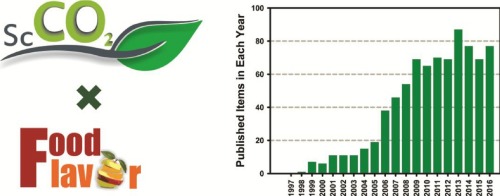Journal of CO2 Utilization ( IF 7.2 ) Pub Date : 2017-12-06 , DOI: 10.1016/j.jcou.2017.11.011 Arthur Luiz Baião Dias , Philipe dos Santos , Julian Martínez

|
The demand for fresh and natural products is increasing worldwide. Therefore, new production methods of natural flavor compounds have attracted the attention of food manufacturers. In this scenario, biocatalyzed chemical synthesis is being explored as an alternative to produce flavoring compounds with application in the chemical and food industries. The use of supercritical carbon dioxide (SC-CO2) as the reaction medium in biocatalytic processes enhances the transport properties of substrates in the active site of enzymes, increasing the reaction’s conversion. SC-CO2 has some operational advantages, such as tunability of their properties (density, viscosity, and solubility) and moderate critical conditions (Pc = 7.38 MPa and Tc = 31.05 °C). Besides, these pressure and temperature conditions are in the range of stability of most lipases. Nevertheless, the use of co-solvents, reuse of catalyst, nature of lipases (free or immobilized) and pressurization/depressurization steps need to be evaluated in the biocatalyzed production of flavoring compounds in SC-CO2. Careful evaluation of these parameters is necessary to obtain an optimal ratio between enzyme/substrates/solvents. In this work, the use of supercritical carbon dioxide (SC-CO2) for the biocatalyzed chemical synthesis of flavor esters using lipases as a catalyst is reviewed.
中文翻译:

超临界CO 2技术在脂肪酶催化反应中生产风味酯化合物的研究进展
全球对新鲜和天然产品的需求正在增长。因此,天然香料化合物的新生产方法引起了食品制造商的关注。在这种情况下,正在探索生物催化的化学合成方法,以替代生产调味化合物的方法,并将其应用于化学和食品工业中。在生物催化过程中,使用超临界二氧化碳(SC-CO 2)作为反应介质可增强酶活性位点上底物的转运性能,从而提高反应的转化率。SC-CO 2具有一些操作优势,例如其性能(密度,粘度和溶解度)的可调性和中等临界条件(Pc = 7.38 MPa和Tc = 31.05°C)。此外,这些压力和温度条件在大多数脂肪酶的稳定性范围内。然而,在SC-CO 2中生物催化生产调味化合物时,需要评估助溶剂的使用,催化剂的再利用,脂肪酶的性质(游离或固定)和加压/降压步骤。为了获得酶/底物/溶剂之间的最佳比例,必须仔细评估这些参数。在这项工作中,综述了使用超临界二氧化碳(SC-CO 2)进行以脂肪酶为催化剂的风味酯的生物催化化学合成。











































 京公网安备 11010802027423号
京公网安备 11010802027423号